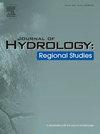Long-term prediction of Poyang Lake water level by combining multi-scale isometric convolution network with quantile regression
IF 4.7
2区 地球科学
Q1 WATER RESOURCES
引用次数: 0
Abstract
Study region
The Poyang Lake basin, China
Study focus
Deep learning (DL) models have been widely applied to lake water level (WL) forecasts at short lead times. However, long-term prediction remains a significant challenge. This study introduces a novel multi-scale isometric convolution network (MICN) model to predict long-term lake WL for the first time. Additionally, the quantile regression (QR) method is incorporated into MICN to generate interval forecasts, offering probabilistic ranges of future WL to enhance risk management.
New hydrological insights for the region
The novel MICN model, which comprehensively incorporates both local and global features, successfully achieved robust predictions of Poyang Lake (PYL) WL. In particular, the long-term forecasts (30 days) have been significantly improved, with the Nash-Sutcliffe Efficiency Coefficient (NSE) exceeding 0.98 at each site. Furthermore, the Root Mean Square Error (RMSE) was improved by more than 20 % compared to the next best-performing DL model. Meanwhile, the hybrid QRMICN model demonstrated satisfactory performance in interval prediction for the short-term horizons. The Predicted Interval Coverage Probability (PICP) at four tested stations reached 0.9, while the Predicted Interval Normalized Average Width (PINAW) remained narrow, indicating that the future predicted WL can be well included in the given intervals. This study offers an effective solution for the prediction of PYL WL with highly complex characteristics, which can be also extended to other hydrological variables.
求助全文
约1分钟内获得全文
求助全文
来源期刊

Journal of Hydrology-Regional Studies
Earth and Planetary Sciences-Earth and Planetary Sciences (miscellaneous)
CiteScore
6.70
自引率
8.50%
发文量
284
审稿时长
60 days
期刊介绍:
Journal of Hydrology: Regional Studies publishes original research papers enhancing the science of hydrology and aiming at region-specific problems, past and future conditions, analysis, review and solutions. The journal particularly welcomes research papers that deliver new insights into region-specific hydrological processes and responses to changing conditions, as well as contributions that incorporate interdisciplinarity and translational science.
 求助内容:
求助内容: 应助结果提醒方式:
应助结果提醒方式:


